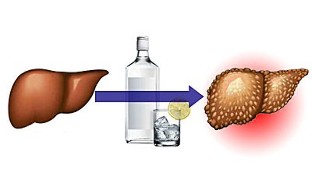The most common consequence of alcohol consumption is liver disease. There are many myths about the less danger of drinking vodka, beer or wine. All alcoholic beverages contain ethanol, a potentially toxic substance, so there are no small or beneficial doses.
Adverse effects of alcohol are possible, even in small doses, but for a longer period of time.
Why is alcohol bad for your health?
If alcohol is consumed frequently and in excess, it can not only be addictive, but can also cause many organic diseases. Ethanol itself and components produced during the production of alcohol can be harmful to health.
The following organs are most affected:
- liver (alcoholic hepatic steatosis, hepatitis, liver cirrhosis);
- stomach (stomach ulcer, dyspepsia);
- colon (colon cancer);
- pancreas (pancreatitis).
Alcohol is highly toxic and addictive. Therefore, it is so difficult for many to quit drinking immediately and ineffectively. The lethal dose of ethanol is 8 grams per 1 kg of body weight. Therefore, when drinking beer, vodka or beverages, you should not forget about moderation in both quantity and frequency of consumption. Alcohol is a source of so-called empty calories. Consumption of large amounts leads to the development of excess weight (1 g of ethanol-7 kcal).
Alcohol promotes the development of various diseases and exacerbates the symptoms of existing ones.
Therefore, it is worth drinking small amounts, you can choose drinks that are potentially less harmful. You should also be wary of certain compounds that worsen the toxicity of ethanol. But even if we follow these rules, the negative consequences of drinking will sooner or later be felt.
What determines the harmfulness of alcohol?
The effects of alcohol on the body depend on various factors. What is important is the type and amount of ethanol consumed, sex, genetic factors, time and way of consumption, type of medication used, and general health. Similarly, the effectiveness of alcohol treatment depends.
Concomitant consumption of alcohol and tobacco is extremely harmful to the body.
A strong link between alcohol and development has been proven:
- mouth tumors;
- Neoplasm of the tonsils;
- throat cancer.

People who drink alcohol have a 30% increased risk of developing these tumors. In this case, if alcohol is combined with smoking, the risk increases threefold. At the same time, alcohol and smoking increase the risk of adverse effects of alcohol and severe addiction.
One of the most common mistakes in the development of asthma is to drink alcohol on an empty stomach. This speeds up the absorption of alcohol and causes an increase in hangover symptoms the next day.
For example, the different flavors used to make a drink help to create a hangover by combining many types of alcohol. The smallest hangover occurs after eating high-quality, good vodka.
Ethanol poisoning can also occur with alcohol. Its symptoms are:
- nausea and vomiting;
- dizziness;
- diarrhea;
- dehydration.
Safe drinks - what does it mean?
Numerous scientific studies (from various centers around the world) provide information on the beneficial effects of very small amounts of alcohol on the functioning of individual organs.
A small amount of alcohol contains between 20 and 40 grams of pure ethyl alcohol. Roughly speaking, this is:
- a small bottle of beer;
- a glass of wine;
- 40 ml vodka.
Recommendations should not be taken as an incentive to drink alcohol, it is less for normal, daily consumption. It should be remembered that the negative consequences of alcohol, even in small amounts, can lead to drug addiction.
Many beer and wine drinkers may be tricked into learning the so-called safe amount of alcohol.
A reasonable daily dose was taken, theoretically it should not have a negative effect on the human body, for women it is 20 g of alcohol per day, it is a small bowl of beer or a glass of wine. In turn, in the case of men, 40 g of alcohol per day. These restrictions accept consumption no more than 5 times a week. However, even these amounts can be addictive and can cause serious damage to health.
It should be noted that it is easier for a woman to drink more alcohol than a man. They also have slow metabolic processes for alcohol withdrawal. If a woman consumes the same amount of alcohol, the concentration in the blood reaches a higher level than a man.
Can alcohol have a positive effect?
It doesn't matter what kind of alcohol each person drinks or how much. Exceeding the safe dose can again lead to disease and drug addiction. It is said that it is never too late to drink, but the sooner you do, the better. Thus, its negative effects on the whole body can be avoided.
Numerous studies show that consuming small amounts of alcohol every day increases the amount of good HDL cholesterol. HDL particles work better than bad cholesterol (LDL). This is the only way to get rid of cholesterol in the body.
It should be noted here that alcohol plays an exception and is used only in very small doses. Small amounts of alcohol do not affect total cholesterol. According to research, excessive alcohol consumption, in contrast, leads to an increase in cholesterol levels.
You can often read about the health benefits of drinking wine and beer. In fact, they contain some substances that can have a positive effect on the body. For example, quercetin and resveratrol in red wine have beneficial effects on the cardiovascular system. These are so-called antioxidants.
However, other foods that are the least safe are also a source of antioxidants: red grapes, berries, apples, nuts. Here the negative consequences of alcohol consumption will be more than the good.
How many calories and what substances do alcoholic beverages contain?
Wine contains 8. 5–18% ethanol. The caloric content of wine depends on its type. Sweet wines have the most calories (94-104 kcal per 100 grams). The minimum calories are provided by dry wine (65-68 kcal per 100 g). The wine contains the following:
- flavonoids;
- tannins;
- organic acids;
- calcium;
- potassium;
- phosphorus;
- magnesium;
- hardware;
- Б. vitamins of the group.
Red, dry wine is the least harmful and low in calories and has the most antioxidants. Although the content of many valuable compounds is quite high, wine is an alcoholic beverage containing pure ethanol. This means that even in this form, the negative consequences of alcohol consumption are possible.

The amount of alcohol in beer is very different - between 0. 2, 9-10%. Beer, of course, has about 49 kcal per 100 grams, and dark beer, in turn, has more calories, because about 68 kcal per 100 grams.
Beer contains antioxidants and B vitamins, magnesium, potassium, phosphorus. You can find a lot of information about the beneficial effects of beer on the urinary system. But beer is also a source of ethanol. It has a beneficial effect on the urinary system, but it does not aggravate the loss to the body.
High-quality vodka, liqueur, cognac contain the most ethyl alcohol - between 15 and 80%. It is also very high in calories, there are about 220 kcal per 100 grams of vodka.
No matter how little alcohol is consumed, it still has a devastating effect on the whole body. Don't be misled about the benefits of alcohol. Alcohol is an absolutely unnecessary substance and is sometimes dangerous for the functioning of organs and systems. Treatment of alcoholism is a very complex and often lengthy procedure that requires special efforts of the patient, relatives and medical staff. The negative consequences of drinking alcohol will be more serious than the pleasure of being drunk.
























